Game Design Project: Idea Generation, Prototype, Testing and Revision
VerifiedAdded on 2022/12/26
|9
|2628
|99
Project
AI Summary
This project delves into the multifaceted world of game design, commencing with an exploration of various idea generation techniques employed by industry professionals. It evaluates the critical factors that contribute to the formulation of successful game concepts, providing a foundation for the development of a comprehensive game design proposal. The project then transitions into the practical realm, encompassing the creation of a functional game prototype utilizing industry-standard tools and techniques. A key aspect of the project involves the iterative refinement of the game prototype through rigorous testing and revision, ensuring a polished and engaging final product. The report provides a detailed overview of the game design process, from initial concept to refined prototype.
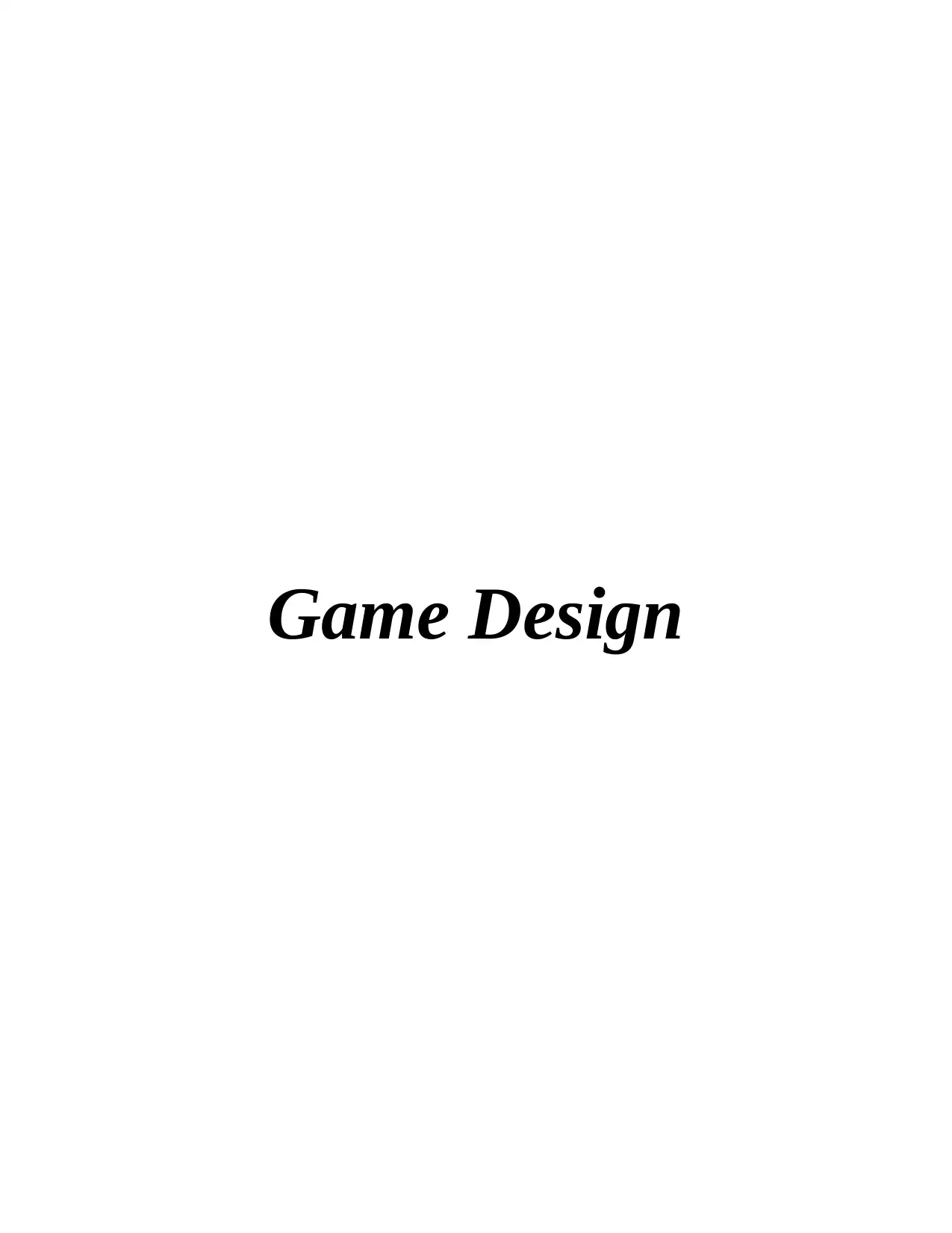
Game Design
Paraphrase This Document
Need a fresh take? Get an instant paraphrase of this document with our AI Paraphraser
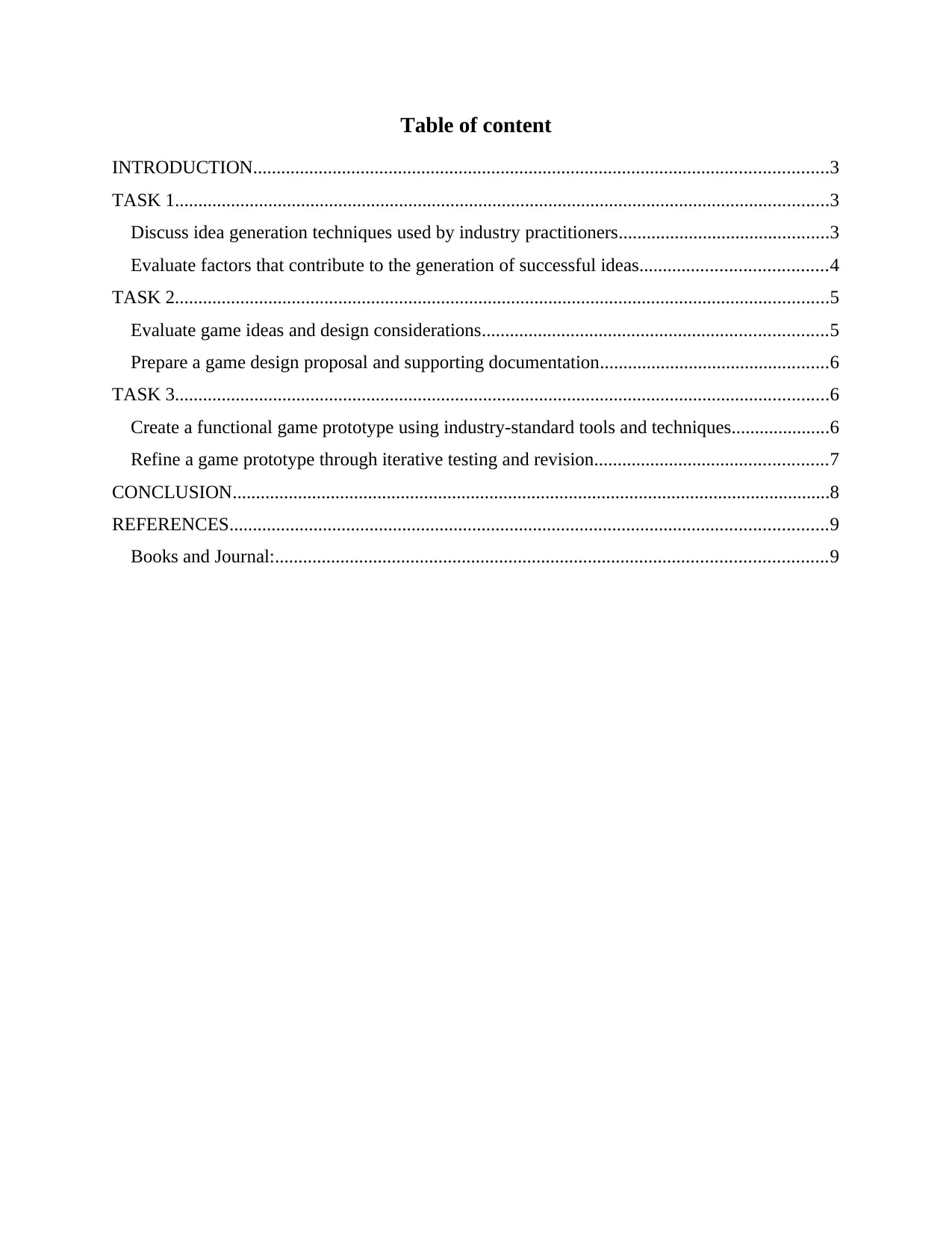
Table of content
INTRODUCTION...........................................................................................................................3
TASK 1............................................................................................................................................3
Discuss idea generation techniques used by industry practitioners.............................................3
Evaluate factors that contribute to the generation of successful ideas........................................4
TASK 2............................................................................................................................................5
Evaluate game ideas and design considerations..........................................................................5
Prepare a game design proposal and supporting documentation.................................................6
TASK 3............................................................................................................................................6
Create a functional game prototype using industry-standard tools and techniques.....................6
Refine a game prototype through iterative testing and revision..................................................7
CONCLUSION................................................................................................................................8
REFERENCES................................................................................................................................9
Books and Journal:......................................................................................................................9
INTRODUCTION...........................................................................................................................3
TASK 1............................................................................................................................................3
Discuss idea generation techniques used by industry practitioners.............................................3
Evaluate factors that contribute to the generation of successful ideas........................................4
TASK 2............................................................................................................................................5
Evaluate game ideas and design considerations..........................................................................5
Prepare a game design proposal and supporting documentation.................................................6
TASK 3............................................................................................................................................6
Create a functional game prototype using industry-standard tools and techniques.....................6
Refine a game prototype through iterative testing and revision..................................................7
CONCLUSION................................................................................................................................8
REFERENCES................................................................................................................................9
Books and Journal:......................................................................................................................9
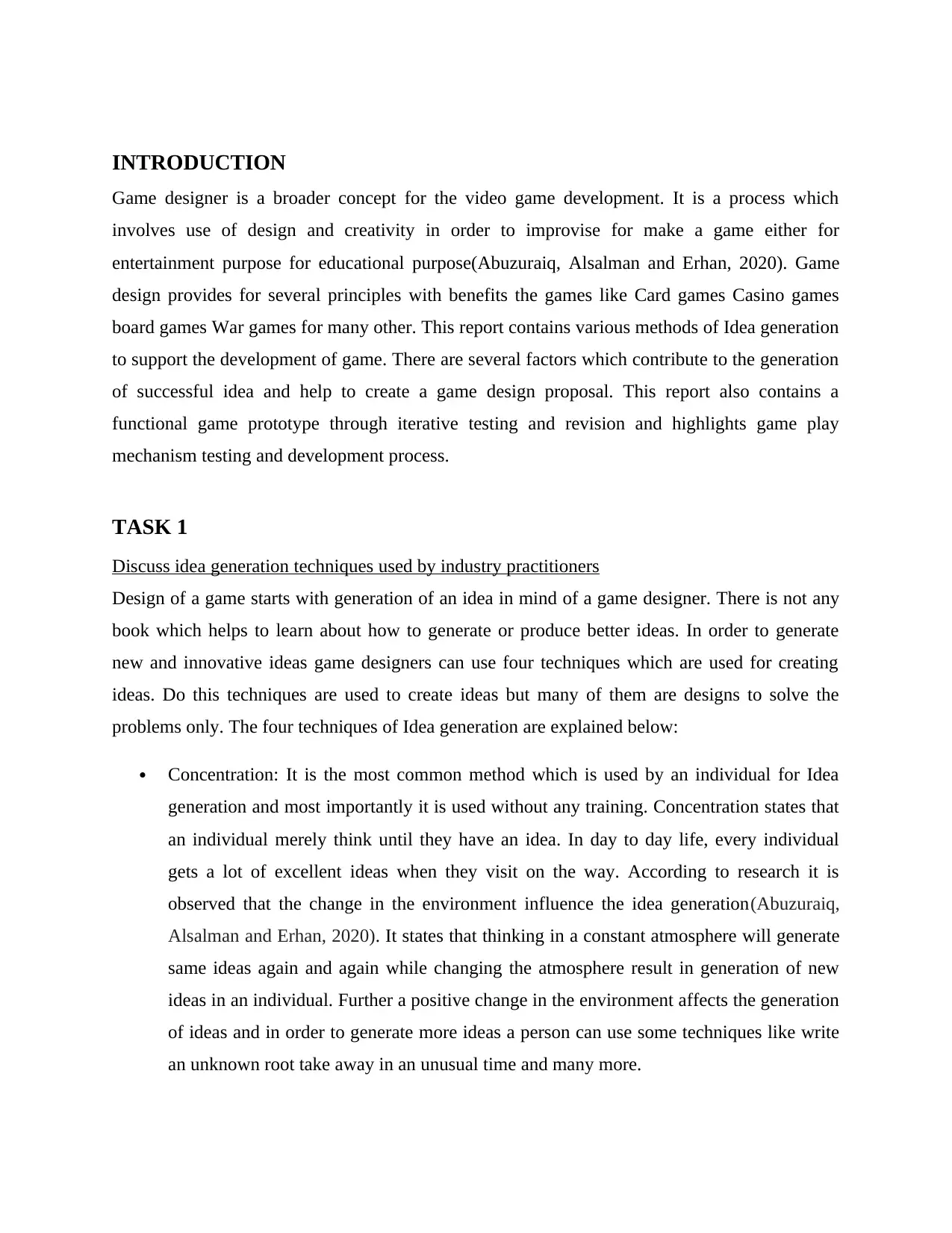
INTRODUCTION
Game designer is a broader concept for the video game development. It is a process which
involves use of design and creativity in order to improvise for make a game either for
entertainment purpose for educational purpose(Abuzuraiq, Alsalman and Erhan, 2020). Game
design provides for several principles with benefits the games like Card games Casino games
board games War games for many other. This report contains various methods of Idea generation
to support the development of game. There are several factors which contribute to the generation
of successful idea and help to create a game design proposal. This report also contains a
functional game prototype through iterative testing and revision and highlights game play
mechanism testing and development process.
TASK 1
Discuss idea generation techniques used by industry practitioners
Design of a game starts with generation of an idea in mind of a game designer. There is not any
book which helps to learn about how to generate or produce better ideas. In order to generate
new and innovative ideas game designers can use four techniques which are used for creating
ideas. Do this techniques are used to create ideas but many of them are designs to solve the
problems only. The four techniques of Idea generation are explained below:
Concentration: It is the most common method which is used by an individual for Idea
generation and most importantly it is used without any training. Concentration states that
an individual merely think until they have an idea. In day to day life, every individual
gets a lot of excellent ideas when they visit on the way. According to research it is
observed that the change in the environment influence the idea generation(Abuzuraiq,
Alsalman and Erhan, 2020). It states that thinking in a constant atmosphere will generate
same ideas again and again while changing the atmosphere result in generation of new
ideas in an individual. Further a positive change in the environment affects the generation
of ideas and in order to generate more ideas a person can use some techniques like write
an unknown root take away in an unusual time and many more.
Game designer is a broader concept for the video game development. It is a process which
involves use of design and creativity in order to improvise for make a game either for
entertainment purpose for educational purpose(Abuzuraiq, Alsalman and Erhan, 2020). Game
design provides for several principles with benefits the games like Card games Casino games
board games War games for many other. This report contains various methods of Idea generation
to support the development of game. There are several factors which contribute to the generation
of successful idea and help to create a game design proposal. This report also contains a
functional game prototype through iterative testing and revision and highlights game play
mechanism testing and development process.
TASK 1
Discuss idea generation techniques used by industry practitioners
Design of a game starts with generation of an idea in mind of a game designer. There is not any
book which helps to learn about how to generate or produce better ideas. In order to generate
new and innovative ideas game designers can use four techniques which are used for creating
ideas. Do this techniques are used to create ideas but many of them are designs to solve the
problems only. The four techniques of Idea generation are explained below:
Concentration: It is the most common method which is used by an individual for Idea
generation and most importantly it is used without any training. Concentration states that
an individual merely think until they have an idea. In day to day life, every individual
gets a lot of excellent ideas when they visit on the way. According to research it is
observed that the change in the environment influence the idea generation(Abuzuraiq,
Alsalman and Erhan, 2020). It states that thinking in a constant atmosphere will generate
same ideas again and again while changing the atmosphere result in generation of new
ideas in an individual. Further a positive change in the environment affects the generation
of ideas and in order to generate more ideas a person can use some techniques like write
an unknown root take away in an unusual time and many more.
⊘ This is a preview!⊘
Do you want full access?
Subscribe today to unlock all pages.

Trusted by 1+ million students worldwide
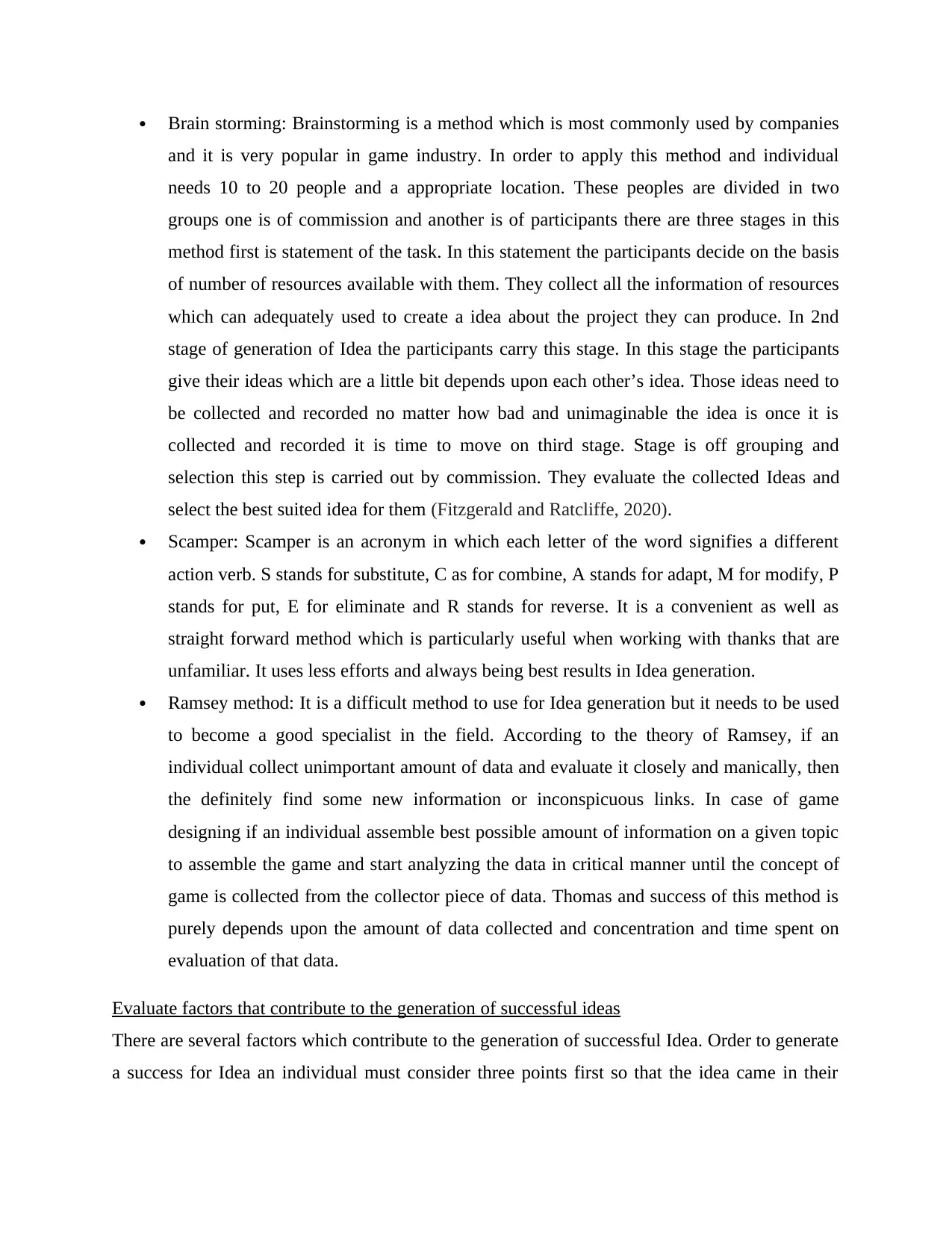
Brain storming: Brainstorming is a method which is most commonly used by companies
and it is very popular in game industry. In order to apply this method and individual
needs 10 to 20 people and a appropriate location. These peoples are divided in two
groups one is of commission and another is of participants there are three stages in this
method first is statement of the task. In this statement the participants decide on the basis
of number of resources available with them. They collect all the information of resources
which can adequately used to create a idea about the project they can produce. In 2nd
stage of generation of Idea the participants carry this stage. In this stage the participants
give their ideas which are a little bit depends upon each other’s idea. Those ideas need to
be collected and recorded no matter how bad and unimaginable the idea is once it is
collected and recorded it is time to move on third stage. Stage is off grouping and
selection this step is carried out by commission. They evaluate the collected Ideas and
select the best suited idea for them (Fitzgerald and Ratcliffe, 2020).
Scamper: Scamper is an acronym in which each letter of the word signifies a different
action verb. S stands for substitute, C as for combine, A stands for adapt, M for modify, P
stands for put, E for eliminate and R stands for reverse. It is a convenient as well as
straight forward method which is particularly useful when working with thanks that are
unfamiliar. It uses less efforts and always being best results in Idea generation.
Ramsey method: It is a difficult method to use for Idea generation but it needs to be used
to become a good specialist in the field. According to the theory of Ramsey, if an
individual collect unimportant amount of data and evaluate it closely and manically, then
the definitely find some new information or inconspicuous links. In case of game
designing if an individual assemble best possible amount of information on a given topic
to assemble the game and start analyzing the data in critical manner until the concept of
game is collected from the collector piece of data. Thomas and success of this method is
purely depends upon the amount of data collected and concentration and time spent on
evaluation of that data.
Evaluate factors that contribute to the generation of successful ideas
There are several factors which contribute to the generation of successful Idea. Order to generate
a success for Idea an individual must consider three points first so that the idea came in their
and it is very popular in game industry. In order to apply this method and individual
needs 10 to 20 people and a appropriate location. These peoples are divided in two
groups one is of commission and another is of participants there are three stages in this
method first is statement of the task. In this statement the participants decide on the basis
of number of resources available with them. They collect all the information of resources
which can adequately used to create a idea about the project they can produce. In 2nd
stage of generation of Idea the participants carry this stage. In this stage the participants
give their ideas which are a little bit depends upon each other’s idea. Those ideas need to
be collected and recorded no matter how bad and unimaginable the idea is once it is
collected and recorded it is time to move on third stage. Stage is off grouping and
selection this step is carried out by commission. They evaluate the collected Ideas and
select the best suited idea for them (Fitzgerald and Ratcliffe, 2020).
Scamper: Scamper is an acronym in which each letter of the word signifies a different
action verb. S stands for substitute, C as for combine, A stands for adapt, M for modify, P
stands for put, E for eliminate and R stands for reverse. It is a convenient as well as
straight forward method which is particularly useful when working with thanks that are
unfamiliar. It uses less efforts and always being best results in Idea generation.
Ramsey method: It is a difficult method to use for Idea generation but it needs to be used
to become a good specialist in the field. According to the theory of Ramsey, if an
individual collect unimportant amount of data and evaluate it closely and manically, then
the definitely find some new information or inconspicuous links. In case of game
designing if an individual assemble best possible amount of information on a given topic
to assemble the game and start analyzing the data in critical manner until the concept of
game is collected from the collector piece of data. Thomas and success of this method is
purely depends upon the amount of data collected and concentration and time spent on
evaluation of that data.
Evaluate factors that contribute to the generation of successful ideas
There are several factors which contribute to the generation of successful Idea. Order to generate
a success for Idea an individual must consider three points first so that the idea came in their
Paraphrase This Document
Need a fresh take? Get an instant paraphrase of this document with our AI Paraphraser
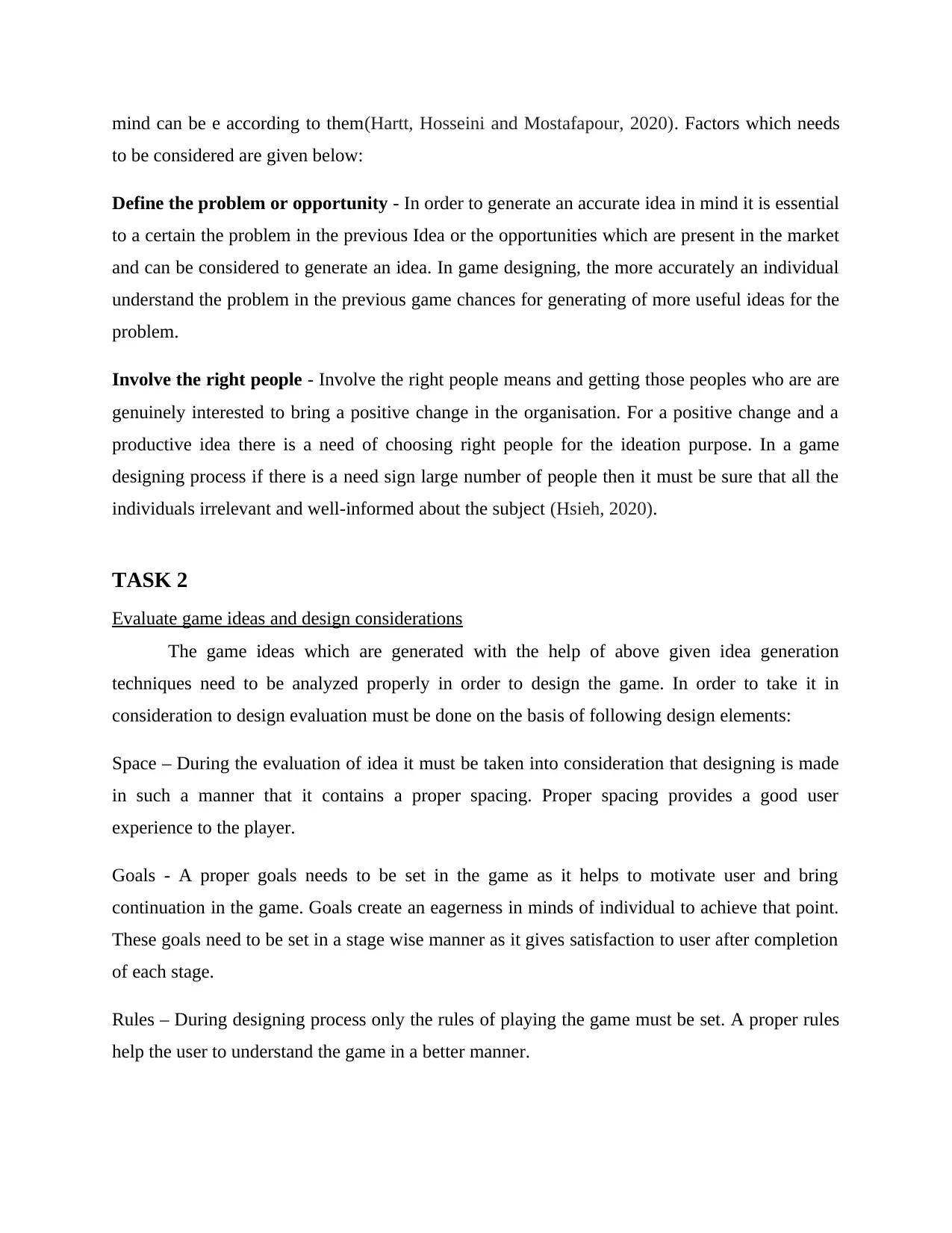
mind can be e according to them(Hartt, Hosseini and Mostafapour, 2020). Factors which needs
to be considered are given below:
Define the problem or opportunity - In order to generate an accurate idea in mind it is essential
to a certain the problem in the previous Idea or the opportunities which are present in the market
and can be considered to generate an idea. In game designing, the more accurately an individual
understand the problem in the previous game chances for generating of more useful ideas for the
problem.
Involve the right people - Involve the right people means and getting those peoples who are are
genuinely interested to bring a positive change in the organisation. For a positive change and a
productive idea there is a need of choosing right people for the ideation purpose. In a game
designing process if there is a need sign large number of people then it must be sure that all the
individuals irrelevant and well-informed about the subject (Hsieh, 2020).
TASK 2
Evaluate game ideas and design considerations
The game ideas which are generated with the help of above given idea generation
techniques need to be analyzed properly in order to design the game. In order to take it in
consideration to design evaluation must be done on the basis of following design elements:
Space – During the evaluation of idea it must be taken into consideration that designing is made
in such a manner that it contains a proper spacing. Proper spacing provides a good user
experience to the player.
Goals - A proper goals needs to be set in the game as it helps to motivate user and bring
continuation in the game. Goals create an eagerness in minds of individual to achieve that point.
These goals need to be set in a stage wise manner as it gives satisfaction to user after completion
of each stage.
Rules – During designing process only the rules of playing the game must be set. A proper rules
help the user to understand the game in a better manner.
to be considered are given below:
Define the problem or opportunity - In order to generate an accurate idea in mind it is essential
to a certain the problem in the previous Idea or the opportunities which are present in the market
and can be considered to generate an idea. In game designing, the more accurately an individual
understand the problem in the previous game chances for generating of more useful ideas for the
problem.
Involve the right people - Involve the right people means and getting those peoples who are are
genuinely interested to bring a positive change in the organisation. For a positive change and a
productive idea there is a need of choosing right people for the ideation purpose. In a game
designing process if there is a need sign large number of people then it must be sure that all the
individuals irrelevant and well-informed about the subject (Hsieh, 2020).
TASK 2
Evaluate game ideas and design considerations
The game ideas which are generated with the help of above given idea generation
techniques need to be analyzed properly in order to design the game. In order to take it in
consideration to design evaluation must be done on the basis of following design elements:
Space – During the evaluation of idea it must be taken into consideration that designing is made
in such a manner that it contains a proper spacing. Proper spacing provides a good user
experience to the player.
Goals - A proper goals needs to be set in the game as it helps to motivate user and bring
continuation in the game. Goals create an eagerness in minds of individual to achieve that point.
These goals need to be set in a stage wise manner as it gives satisfaction to user after completion
of each stage.
Rules – During designing process only the rules of playing the game must be set. A proper rules
help the user to understand the game in a better manner.
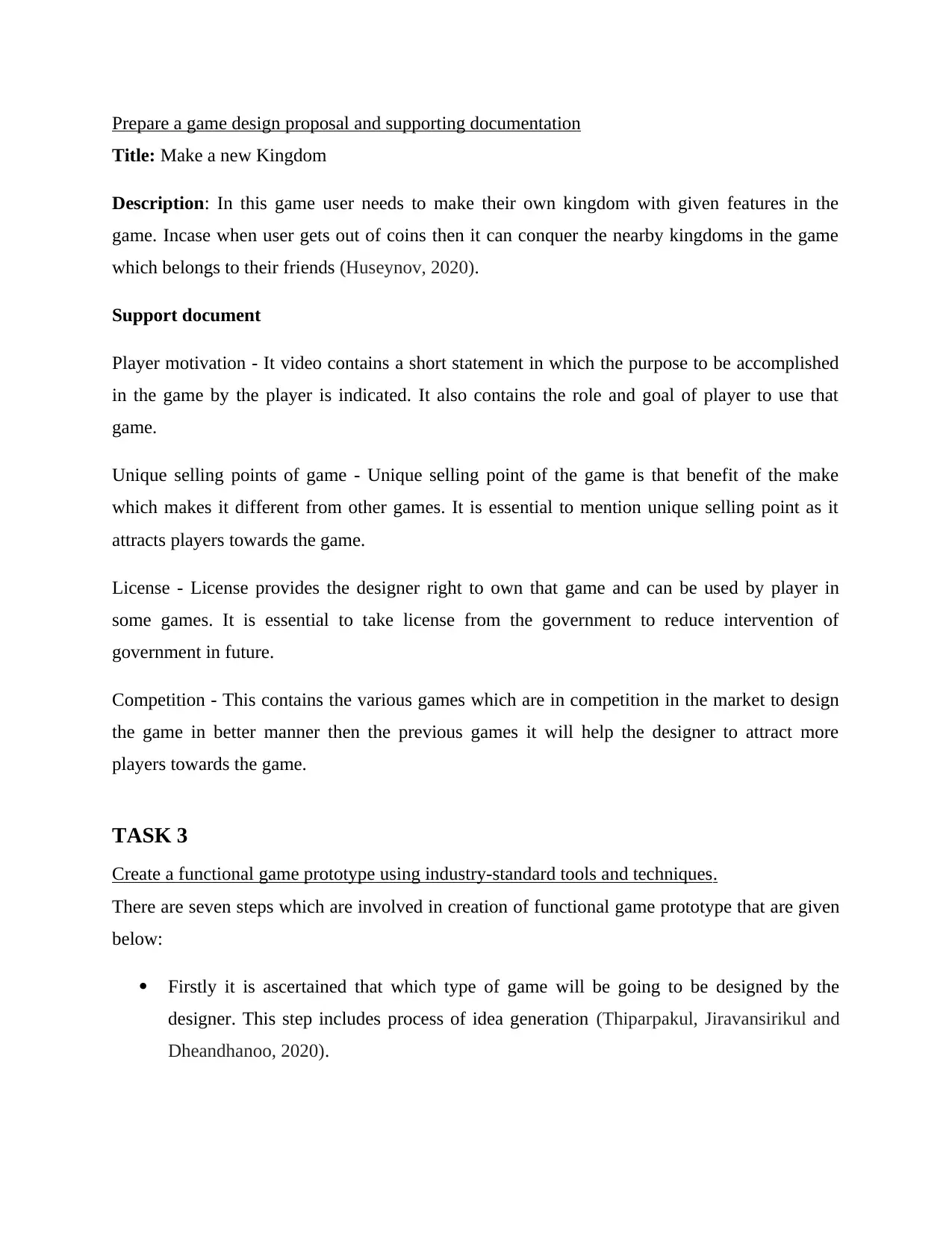
Prepare a game design proposal and supporting documentation
Title: Make a new Kingdom
Description: In this game user needs to make their own kingdom with given features in the
game. Incase when user gets out of coins then it can conquer the nearby kingdoms in the game
which belongs to their friends (Huseynov, 2020).
Support document
Player motivation - It video contains a short statement in which the purpose to be accomplished
in the game by the player is indicated. It also contains the role and goal of player to use that
game.
Unique selling points of game - Unique selling point of the game is that benefit of the make
which makes it different from other games. It is essential to mention unique selling point as it
attracts players towards the game.
License - License provides the designer right to own that game and can be used by player in
some games. It is essential to take license from the government to reduce intervention of
government in future.
Competition - This contains the various games which are in competition in the market to design
the game in better manner then the previous games it will help the designer to attract more
players towards the game.
TASK 3
Create a functional game prototype using industry-standard tools and techniques.
There are seven steps which are involved in creation of functional game prototype that are given
below:
Firstly it is ascertained that which type of game will be going to be designed by the
designer. This step includes process of idea generation (Thiparpakul, Jiravansirikul and
Dheandhanoo, 2020).
Title: Make a new Kingdom
Description: In this game user needs to make their own kingdom with given features in the
game. Incase when user gets out of coins then it can conquer the nearby kingdoms in the game
which belongs to their friends (Huseynov, 2020).
Support document
Player motivation - It video contains a short statement in which the purpose to be accomplished
in the game by the player is indicated. It also contains the role and goal of player to use that
game.
Unique selling points of game - Unique selling point of the game is that benefit of the make
which makes it different from other games. It is essential to mention unique selling point as it
attracts players towards the game.
License - License provides the designer right to own that game and can be used by player in
some games. It is essential to take license from the government to reduce intervention of
government in future.
Competition - This contains the various games which are in competition in the market to design
the game in better manner then the previous games it will help the designer to attract more
players towards the game.
TASK 3
Create a functional game prototype using industry-standard tools and techniques.
There are seven steps which are involved in creation of functional game prototype that are given
below:
Firstly it is ascertained that which type of game will be going to be designed by the
designer. This step includes process of idea generation (Thiparpakul, Jiravansirikul and
Dheandhanoo, 2020).
⊘ This is a preview!⊘
Do you want full access?
Subscribe today to unlock all pages.

Trusted by 1+ million students worldwide
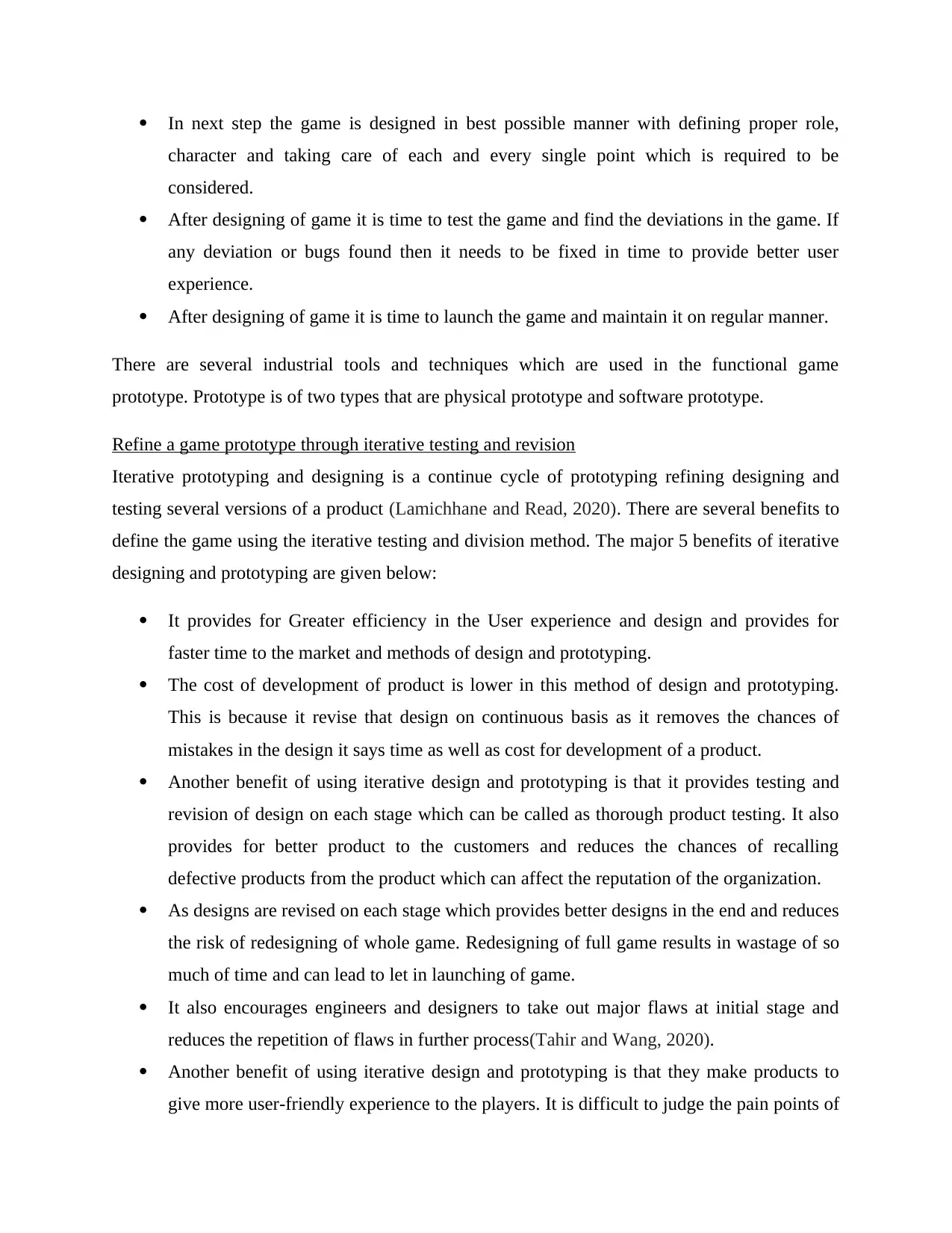
In next step the game is designed in best possible manner with defining proper role,
character and taking care of each and every single point which is required to be
considered.
After designing of game it is time to test the game and find the deviations in the game. If
any deviation or bugs found then it needs to be fixed in time to provide better user
experience.
After designing of game it is time to launch the game and maintain it on regular manner.
There are several industrial tools and techniques which are used in the functional game
prototype. Prototype is of two types that are physical prototype and software prototype.
Refine a game prototype through iterative testing and revision
Iterative prototyping and designing is a continue cycle of prototyping refining designing and
testing several versions of a product (Lamichhane and Read, 2020). There are several benefits to
define the game using the iterative testing and division method. The major 5 benefits of iterative
designing and prototyping are given below:
It provides for Greater efficiency in the User experience and design and provides for
faster time to the market and methods of design and prototyping.
The cost of development of product is lower in this method of design and prototyping.
This is because it revise that design on continuous basis as it removes the chances of
mistakes in the design it says time as well as cost for development of a product.
Another benefit of using iterative design and prototyping is that it provides testing and
revision of design on each stage which can be called as thorough product testing. It also
provides for better product to the customers and reduces the chances of recalling
defective products from the product which can affect the reputation of the organization.
As designs are revised on each stage which provides better designs in the end and reduces
the risk of redesigning of whole game. Redesigning of full game results in wastage of so
much of time and can lead to let in launching of game.
It also encourages engineers and designers to take out major flaws at initial stage and
reduces the repetition of flaws in further process(Tahir and Wang, 2020).
Another benefit of using iterative design and prototyping is that they make products to
give more user-friendly experience to the players. It is difficult to judge the pain points of
character and taking care of each and every single point which is required to be
considered.
After designing of game it is time to test the game and find the deviations in the game. If
any deviation or bugs found then it needs to be fixed in time to provide better user
experience.
After designing of game it is time to launch the game and maintain it on regular manner.
There are several industrial tools and techniques which are used in the functional game
prototype. Prototype is of two types that are physical prototype and software prototype.
Refine a game prototype through iterative testing and revision
Iterative prototyping and designing is a continue cycle of prototyping refining designing and
testing several versions of a product (Lamichhane and Read, 2020). There are several benefits to
define the game using the iterative testing and division method. The major 5 benefits of iterative
designing and prototyping are given below:
It provides for Greater efficiency in the User experience and design and provides for
faster time to the market and methods of design and prototyping.
The cost of development of product is lower in this method of design and prototyping.
This is because it revise that design on continuous basis as it removes the chances of
mistakes in the design it says time as well as cost for development of a product.
Another benefit of using iterative design and prototyping is that it provides testing and
revision of design on each stage which can be called as thorough product testing. It also
provides for better product to the customers and reduces the chances of recalling
defective products from the product which can affect the reputation of the organization.
As designs are revised on each stage which provides better designs in the end and reduces
the risk of redesigning of whole game. Redesigning of full game results in wastage of so
much of time and can lead to let in launching of game.
It also encourages engineers and designers to take out major flaws at initial stage and
reduces the repetition of flaws in further process(Tahir and Wang, 2020).
Another benefit of using iterative design and prototyping is that they make products to
give more user-friendly experience to the players. It is difficult to judge the pain points of
Paraphrase This Document
Need a fresh take? Get an instant paraphrase of this document with our AI Paraphraser
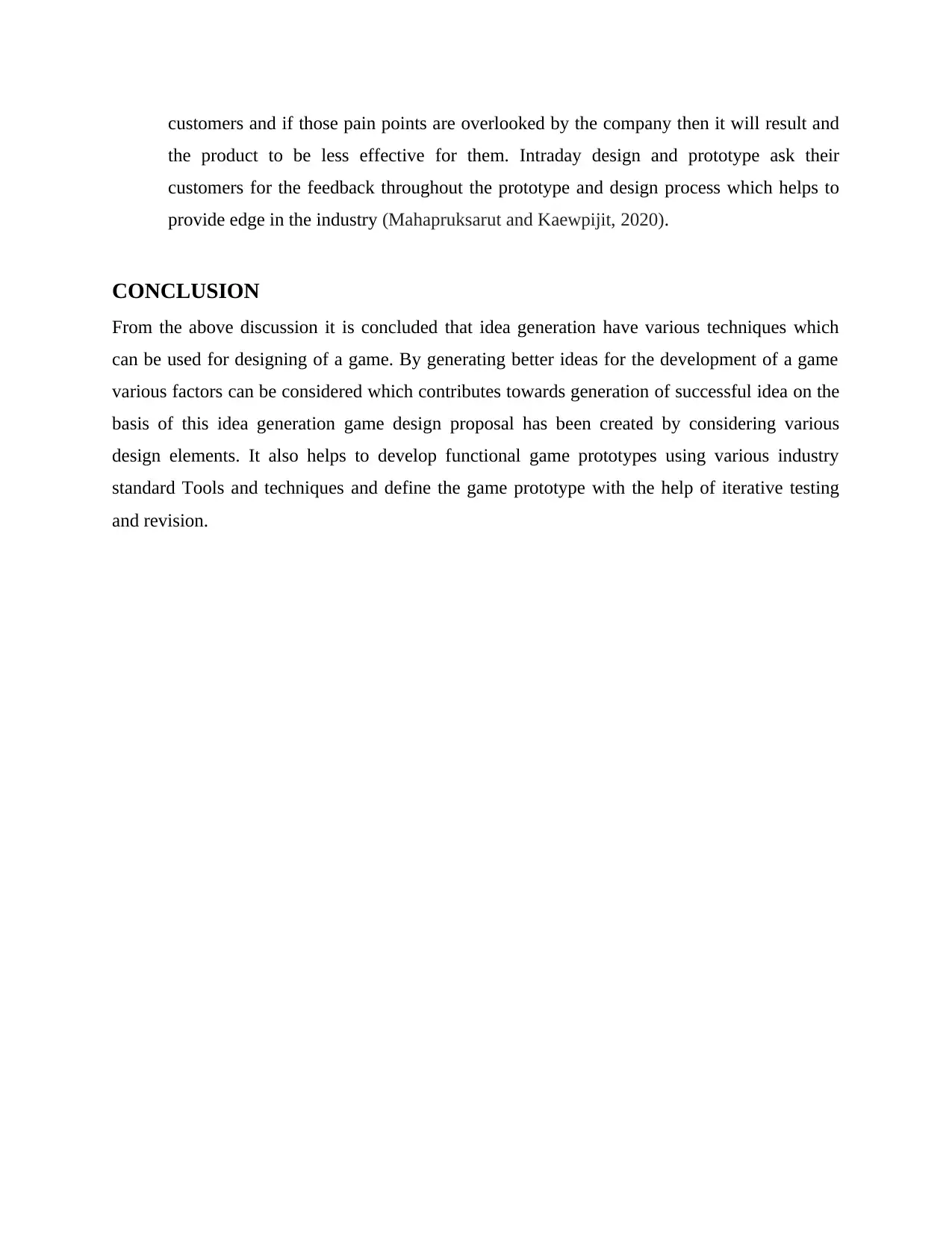
customers and if those pain points are overlooked by the company then it will result and
the product to be less effective for them. Intraday design and prototype ask their
customers for the feedback throughout the prototype and design process which helps to
provide edge in the industry (Mahapruksarut and Kaewpijit, 2020).
CONCLUSION
From the above discussion it is concluded that idea generation have various techniques which
can be used for designing of a game. By generating better ideas for the development of a game
various factors can be considered which contributes towards generation of successful idea on the
basis of this idea generation game design proposal has been created by considering various
design elements. It also helps to develop functional game prototypes using various industry
standard Tools and techniques and define the game prototype with the help of iterative testing
and revision.
the product to be less effective for them. Intraday design and prototype ask their
customers for the feedback throughout the prototype and design process which helps to
provide edge in the industry (Mahapruksarut and Kaewpijit, 2020).
CONCLUSION
From the above discussion it is concluded that idea generation have various techniques which
can be used for designing of a game. By generating better ideas for the development of a game
various factors can be considered which contributes towards generation of successful idea on the
basis of this idea generation game design proposal has been created by considering various
design elements. It also helps to develop functional game prototypes using various industry
standard Tools and techniques and define the game prototype with the help of iterative testing
and revision.
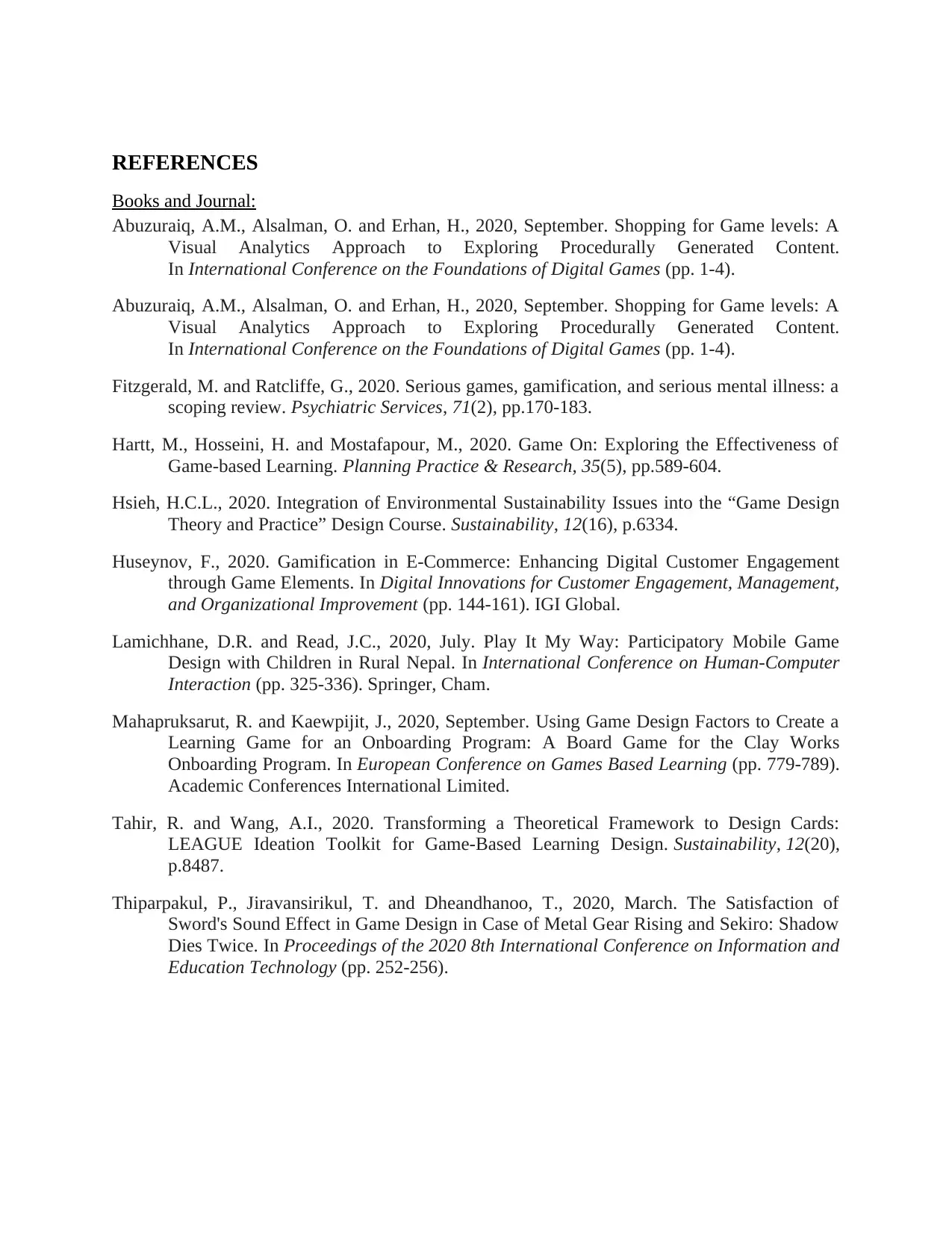
REFERENCES
Books and Journal:
Abuzuraiq, A.M., Alsalman, O. and Erhan, H., 2020, September. Shopping for Game levels: A
Visual Analytics Approach to Exploring Procedurally Generated Content.
In International Conference on the Foundations of Digital Games (pp. 1-4).
Abuzuraiq, A.M., Alsalman, O. and Erhan, H., 2020, September. Shopping for Game levels: A
Visual Analytics Approach to Exploring Procedurally Generated Content.
In International Conference on the Foundations of Digital Games (pp. 1-4).
Fitzgerald, M. and Ratcliffe, G., 2020. Serious games, gamification, and serious mental illness: a
scoping review. Psychiatric Services, 71(2), pp.170-183.
Hartt, M., Hosseini, H. and Mostafapour, M., 2020. Game On: Exploring the Effectiveness of
Game-based Learning. Planning Practice & Research, 35(5), pp.589-604.
Hsieh, H.C.L., 2020. Integration of Environmental Sustainability Issues into the “Game Design
Theory and Practice” Design Course. Sustainability, 12(16), p.6334.
Huseynov, F., 2020. Gamification in E-Commerce: Enhancing Digital Customer Engagement
through Game Elements. In Digital Innovations for Customer Engagement, Management,
and Organizational Improvement (pp. 144-161). IGI Global.
Lamichhane, D.R. and Read, J.C., 2020, July. Play It My Way: Participatory Mobile Game
Design with Children in Rural Nepal. In International Conference on Human-Computer
Interaction (pp. 325-336). Springer, Cham.
Mahapruksarut, R. and Kaewpijit, J., 2020, September. Using Game Design Factors to Create a
Learning Game for an Onboarding Program: A Board Game for the Clay Works
Onboarding Program. In European Conference on Games Based Learning (pp. 779-789).
Academic Conferences International Limited.
Tahir, R. and Wang, A.I., 2020. Transforming a Theoretical Framework to Design Cards:
LEAGUE Ideation Toolkit for Game-Based Learning Design. Sustainability, 12(20),
p.8487.
Thiparpakul, P., Jiravansirikul, T. and Dheandhanoo, T., 2020, March. The Satisfaction of
Sword's Sound Effect in Game Design in Case of Metal Gear Rising and Sekiro: Shadow
Dies Twice. In Proceedings of the 2020 8th International Conference on Information and
Education Technology (pp. 252-256).
Books and Journal:
Abuzuraiq, A.M., Alsalman, O. and Erhan, H., 2020, September. Shopping for Game levels: A
Visual Analytics Approach to Exploring Procedurally Generated Content.
In International Conference on the Foundations of Digital Games (pp. 1-4).
Abuzuraiq, A.M., Alsalman, O. and Erhan, H., 2020, September. Shopping for Game levels: A
Visual Analytics Approach to Exploring Procedurally Generated Content.
In International Conference on the Foundations of Digital Games (pp. 1-4).
Fitzgerald, M. and Ratcliffe, G., 2020. Serious games, gamification, and serious mental illness: a
scoping review. Psychiatric Services, 71(2), pp.170-183.
Hartt, M., Hosseini, H. and Mostafapour, M., 2020. Game On: Exploring the Effectiveness of
Game-based Learning. Planning Practice & Research, 35(5), pp.589-604.
Hsieh, H.C.L., 2020. Integration of Environmental Sustainability Issues into the “Game Design
Theory and Practice” Design Course. Sustainability, 12(16), p.6334.
Huseynov, F., 2020. Gamification in E-Commerce: Enhancing Digital Customer Engagement
through Game Elements. In Digital Innovations for Customer Engagement, Management,
and Organizational Improvement (pp. 144-161). IGI Global.
Lamichhane, D.R. and Read, J.C., 2020, July. Play It My Way: Participatory Mobile Game
Design with Children in Rural Nepal. In International Conference on Human-Computer
Interaction (pp. 325-336). Springer, Cham.
Mahapruksarut, R. and Kaewpijit, J., 2020, September. Using Game Design Factors to Create a
Learning Game for an Onboarding Program: A Board Game for the Clay Works
Onboarding Program. In European Conference on Games Based Learning (pp. 779-789).
Academic Conferences International Limited.
Tahir, R. and Wang, A.I., 2020. Transforming a Theoretical Framework to Design Cards:
LEAGUE Ideation Toolkit for Game-Based Learning Design. Sustainability, 12(20),
p.8487.
Thiparpakul, P., Jiravansirikul, T. and Dheandhanoo, T., 2020, March. The Satisfaction of
Sword's Sound Effect in Game Design in Case of Metal Gear Rising and Sekiro: Shadow
Dies Twice. In Proceedings of the 2020 8th International Conference on Information and
Education Technology (pp. 252-256).
⊘ This is a preview!⊘
Do you want full access?
Subscribe today to unlock all pages.

Trusted by 1+ million students worldwide
1 out of 9
Related Documents
Your All-in-One AI-Powered Toolkit for Academic Success.
+13062052269
info@desklib.com
Available 24*7 on WhatsApp / Email
![[object Object]](/_next/static/media/star-bottom.7253800d.svg)
Unlock your academic potential
Copyright © 2020–2025 A2Z Services. All Rights Reserved. Developed and managed by ZUCOL.





